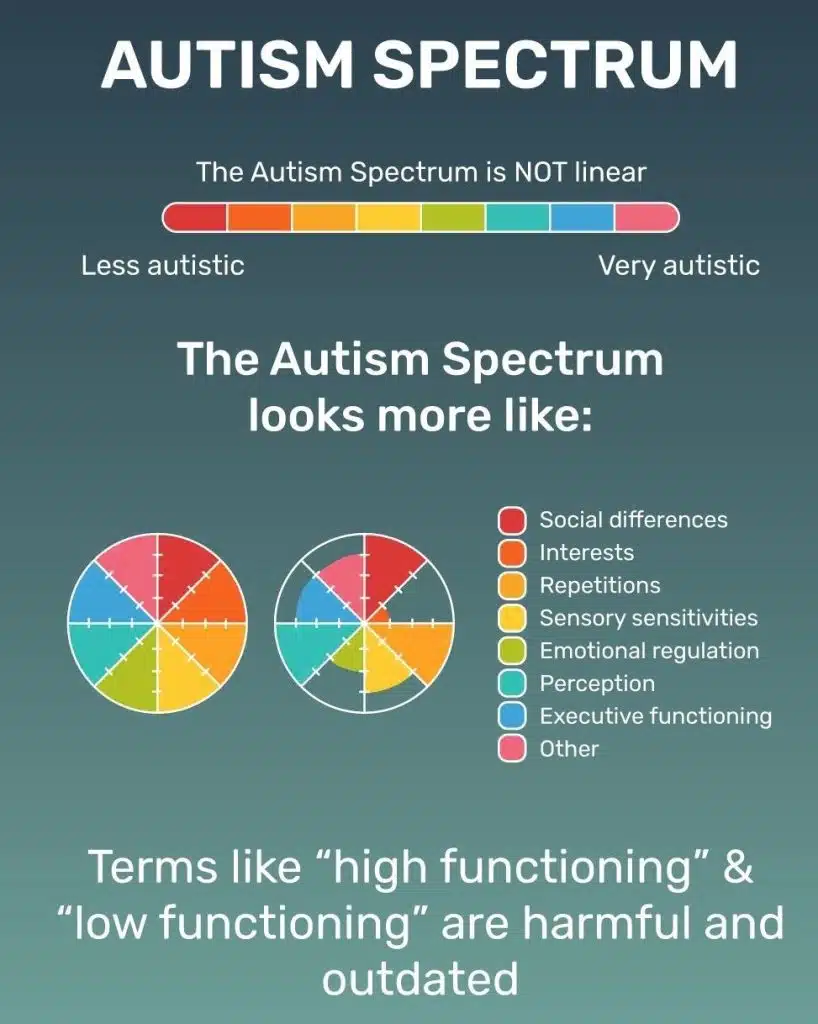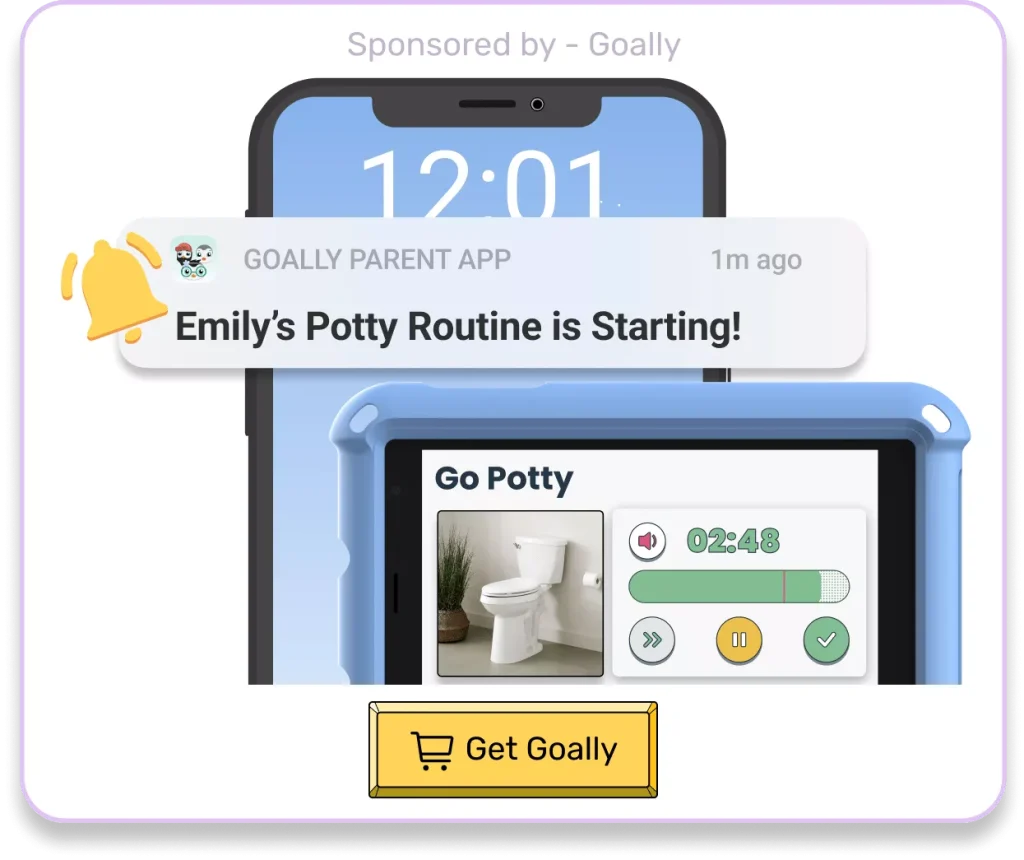Autism is a “spectrum” disorder because there’s a wide range of symptoms that come in different combinations and severities. Some people with ASD may have more challenging symptoms and need more support in their day-to-day lives. Others may have milder symptoms and not as much support. The autism wheel is a visual pie chart of the different aspects of autism and how they are interconnected. It is also known as the pie chart model. So how can the Autism spectrum wheel be helpful? Read on to find out!
Table of Contents
The concept of a “spectrum” reflects that there’s a wide range of possible symptoms with autism. Also that each individual with ASD is unique and experiences the disorder differently. The autism wheel is divided into sections that represent various aspects of autism. Each section highlights specific challenges and strengths experienced by individuals on the spectrum. This is why a simple diagnosis isn’t possible for autism. There’s no one-size-fits-all definition of the disorder that captures the full range of experiences of people with ASD. Instead, doctors and other professionals use various tools and techniques to assess and diagnose ASD. Which takes into account the individual’s specific symptoms and needs.
Read more: What Does It Mean To Be on the Spectrum?
Goally | Visual Scheduler for Autism
Does your child struggle with getting ready in the morning independently? Goally’s routine app on the best tablet for kids breaks down large tasks into small, achievable steps for autistic kids. Create custom routines with your own videos & pictures for every step.
What Are the Limitations of the Spectrum Concept?
- The concept of a “spectrum” can be difficult to use as a means of categorizing and classifying people with ASD. Because the symptoms and characteristics of autism can vary so widely, it can be challenging to determine where an individual falls on the spectrum. Or even to determine whether they are on the spectrum at all. This can lead to inaccurate diagnoses and treatments of ASD. As well as make it difficult to provide appropriate support and services to individuals with autism.
- The spectrum concept can be overly broad. It may not adequately capture the specific needs and challenges faced by individuals with ASD as opposed to the autism wheel. While the term “autism spectrum disorder” refers to a broad range of symptoms that share certain characteristics. It doesn’t reflect the unique experiences and needs of each person with ASD like the autism spectrum wheel does.
- The use of the term “spectrum” to describe ASD can be stigmatizing or misleading. It implies that all people with ASD are similar or that they are all affected by the disorder in the same way. This is not the case. It’s important to recognize that everyone with ASD is an individual with their own strengths, challenges, and needs.
Autism Spectrum Wheel
The autism wheel is a visual representation of the symptoms and characteristics of autism. It’s a circle, with different segments representing different categories or domains of autism symptoms. These categories can include things like social communication and interaction, restricted and repetitive behaviors, and sensory processing. The wheel features a collection of potential autistic traits, such as: Sensory sensitivities, Special interests, Tics and fidgets (i.e., stimming, Anxiety, Social difficulties.)
The wheel also allows each person to express the degree to which they experience these traits. It can help navigate the complexities of autism and guide support and intervention strategies.The wheel acknowledges that autistic people’s symptoms may change and develop through time.

Sponsored by: Goally
"Goally has changed our lives. I no longer nag our son nonstop to complete basic tasks like getting ready for bed or cleaning his room!" — Bryna, Goally Mom Learn more →
You can divide each sector of the autism spectrum wheel into subcategories for specific symptoms. The size or color of each sector may be used to indicate the severity or importance of the symptom or characteristic. Looking at an autism wheel graphic, you can get a sense of the specific symptoms and characteristics that an individual with ASD experiences. You can also see how these symptoms vary in severity or frequency. This can be helpful in understanding an individual’s needs and challenges. It’s also helpful to develop strategies that support and address those needs.
Wrong shortcode initialized
Categories of the Autism Spectrum Wheel
| Category | Description |
|---|---|
| Social Communication and Interaction | Includes symptoms such as difficulty initiating and maintaining conversations, a lack of interest in interacting with others, alongside difficulty understanding and applying nonverbal communication cues like eye contact, facial expressions, and body language. |
| Restricted and Repetitive Behaviors | This category includes symptoms like needing constant routines, displaying repetitive movements or behaviors, or showing intense interests in specific topics or objects. |
| Sensory Processing | This category includes symptoms like difficulty processing sensory inputs such as loud noises, bright lights, certain textures, difficulty regulating emotions, and challenges with self-regulation and self-care. |
| Cognitive and Learning Skills | This category in the autism wheel includes symptoms related to cognitive and learning abilities such as difficulty with problem-solving, memory, and attention, as well as challenges with learning new things. |
| Physical and Medical Needs | This category on the autism spectrum wheel includes symptoms related to physical and medical needs like challenges with self-care, sleep, and physical coordination, as well as any medical conditions or challenges related to autism. |
Goally | Visual Scheduler for Autism
Does your child struggle with getting ready in the morning independently? Goally’s routine app on the best tablet for kids breaks down large tasks into small, achievable steps for autistic kids. Create custom routines with your own videos & pictures for every step.
In the end, the Autism Spectrum Wheel helps us learn more about kids with autism and the special things they can do. It also shows us how they might feel or act differently. By understanding these differences, we can do better at helping our friends with autism feel comfortable and be successful. The Autism Spectrum Wheel teaches everyone why it’s important to be kind and support our friends who are on the autism spectrum. When we learn and grow together, we can make school and life more fun and enjoyable for everyone.
FAQ’s About the Autism Wheel
What is an autism wheel? An autism wheel is a visual tool that helps categorize and understand the various spectrum of symptoms in autism. How does an autism wheel assist in autism understanding? The wheel is divided into categories representing symptoms like social interaction difficulty, sensory issues, cognitive challenges, etc. This aids in focusing on specific areas for improvement. Can the autism wheel be personalized? Yes, the categories in the autism wheel can be personalized based on an individual's specific areas of strength and weakness. What are some typical categories on an autism wheel? Common categories include Social Communication and Interaction, Restricted and Repetitive Behaviors, Sensory Processing, Cognitive and Learning Skills, and Physical and Medical Needs. What's the benefit of using the autism wheel? The autism wheel can help identify areas of difficulty, create targeted strategies for improvement, and track progress over time.
This post was originally published on 01/03/2023. It was updated on 01/10/2024.

Goally
We help parents teach their kids life skills, like doing bedtime and morning independently. Backed by science, we incorporate evidence-based practices and expert-informed designs in all of our apps and content.







